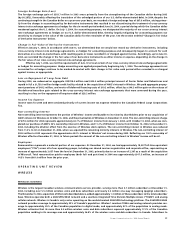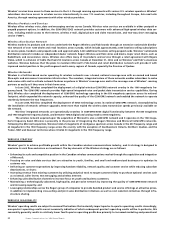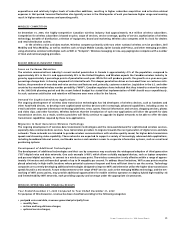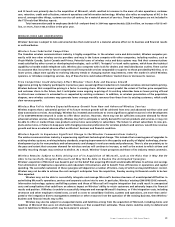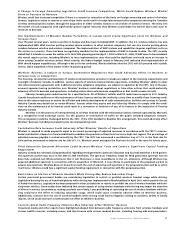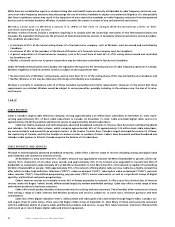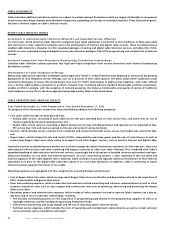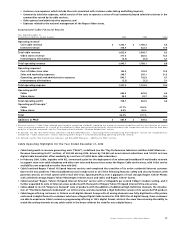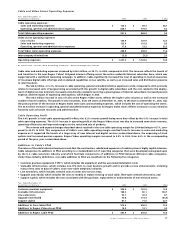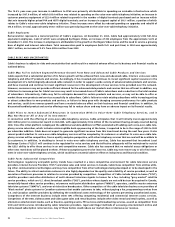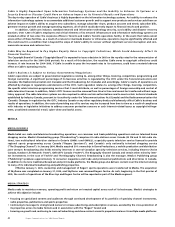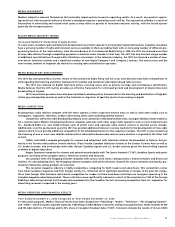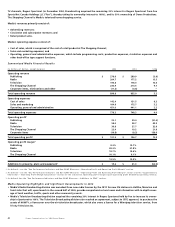Rogers 2004 Annual Report Download - page 35
Download and view the complete annual report
Please find page 35 of the 2004 Rogers annual report below. You can navigate through the pages in the report by either clicking on the pages listed below, or by using the keyword search tool below to find specific information within the annual report.
33
Rogers Communications Inc. 2004 Annual Report
CABLE DISTRIBUTION NETWORK
In addition to the Rogers Video stores, as described above, Cable markets its services through an extensive network of retail locations
across its network footprint, including the Wireless’ independent dealer network, Wireless’ stores and kiosks, and major retail chains
such as RadioShack, Future Shop and Best Buy. It also offers products and services and customer service on its e-business website,
www.rogers.com.
CABLE NETWORKS
Cable’s cable networks in Ontario and New Brunswick, with few exceptions, are interconnected to regional head-ends, where analog
and digital channel lineups are assembled for distribution to customers and Internet traffic is aggregated and routed to and from cus-
tomers, by inter-city fibre-optic rings. The fibre-optic interconnections allow Cable’s multiple Ontario and New Brunswick cable systems
to function as a single cable network. Its remaining subscribers in Newfoundland and Labrador, and New Brunswick are served by local
head-ends. Its two regional head-ends in Toronto, Ontario, and Moncton, New Brunswick, provide the source for most television signals
used in the cable systems.
Cable’s technology architecture is based on a three-tiered structure of primary hubs, optical nodes and co-axial distribution.
The primary hubs, located in each region that it serves, are connected by inter-city fibre-optic systems carrying television, Internet,
network control and monitoring, and administrative traffic. The fibre-optic systems are generally constructed as rings that allow sig-
nals to flow in and out of each primary hub, or head-end, through two paths, providing protection from a fibre cut or other disruption.
These high-capacity fibre-optic networks deliver high performance and reliability and have substantial reserves for future growth in
the form of dark fibre and unused optical wavelengths. Approximately 90% of the homes passed by Cable’s network are fed from
primary hubs, or head-ends, which each serve, on average, 100,000 home areas. The remaining approximately 10% of the homes passed
by Cable’s network are in smaller and more rural systems mostly in New Brunswick and Newfoundland and Labrador, which are, on
average, served by smaller primary hubs.
Optical fibre joins the primary hub to the optical nodes in the cable distribution plant. Final distribution to subscriber homes
from optical nodes uses co-axial cable with two-way amplifiers to support on-demand television and Internet service. Co-axial cable
capacity has been increased repeatedly by introducing more advanced amplifier technologies. Cable believes co-axial cable is the most
cost-effective and widely deployed means of carrying two-way television and Internet services to residential subscribers.
Groups of an average of 640 homes are served from each optical node in a cable architecture commonly referred to as fibre-to-
the-feeder (“FTTF”). The FTTF plant provides bandwidth up to 750 megahertz (“MHz”) or 860 MHz, which includes 37 MHz of bandwidth
used for “upstream” transmission from the subscribers’ premises to the primary hub. Cable believes the upstream bandwidth is suffi-
cient to support multiple cable modem systems, cable telephony, and data traffic from interactive digital set-top terminals for at least
the near-term future. When necessary, additional upstream capacity can be provided by reducing the number of homes served by each
optical node. Fibre cable has been placed to permit a reduction of the average node size from 640 to 300 homes by installing additional
optical transceiver modules and optical transmitters and return receivers in the head-ends and primary hubs.
Cable believes that the 750/860 MHz FTTF architecture provides them with sufficient bandwidth for foreseeable growth in televi-
sion, data and future services, a high-quality picture, advanced two-way capability and increased reliability. In addition, Cable’s clustered
network of cable systems served by regional head-ends facilitate its ability to rapidly introduce new services to subscribers with a
lower capital cost. In new construction projects in major urban areas, Cable is now deploying a cable network architecture commonly
referred to as fibre-to-the-curb (“FTTC”). This architecture provides improved reliability due to fewer active network devices being
deployed. FTTC also provides greater capacity for future narrowcast services.
CABLE STRATEGY
Cable seeks to maximize revenue, operating income, and return on invested capital by leveraging its technologically advanced cable
network to meet the information, entertainment and communications needs of its subscribers, from basic cable television to advanced
two-way cable services, including digital cable, Internet access, PPV, VOD, SVOD, PVR and HDTV. The key elements of the strategy are
as follows:
• Clustering of cable systems in and around metropolitan areas;
• Offering a wide selection of products and services;
• Maintaining technologically advanced cable networks;
• Continuing to focus on increased quality and reliability of service;
• Leveraging its relationships within the Rogers group of companies to provide bundled product and service offerings at attractive
prices, in addition to implementing cross-selling and joint sales distribution initiatives as well as cost-reduction initiatives through
infrastructure sharing;
• Continuing to develop brand awareness and to promote the “Rogers” brand as a symbol of quality, innovation and value and of a
diversified Canadian media and communications company; and
• Deploying advanced IP capabilities to provide high-quality digital primary line voice-over-cable telephony service.
CABLE VOICE-OVER-CABLE TELEPHONY INITIATIVE
As discussed previously, Cable is deploying an advanced broadband Internet Protocol (“IP”) multimedia network to support primary line
voice-over-cable telephony and other new services across its cable service areas.


